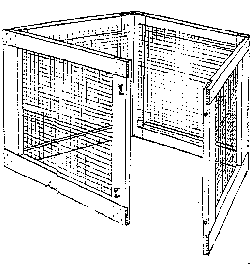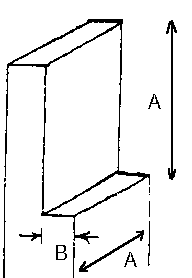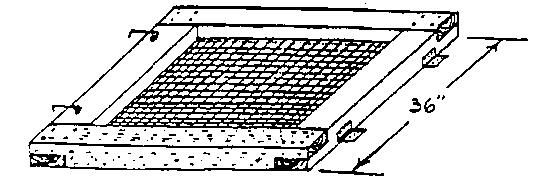- This composting unit is very flexible.
It can be moved easily to turn a pile or to build a new one. Simply
undo the latches, pull the sides apart, and move it. It can also
be used as a stationary unit, and works well in small spaces.
 - MATERIALS
1 - 12' 2"x4"
3 - 12' fir 2"x4"
12' of 36" wide 1/2" hardware cloth
100 - 1 1/2" galvanized no. 8 wood screws
4 - 3" galvanized butt door hinges
150 poultry wire staples or power stapler
1 - 10 oz. tube exterior wood adhesive
4 large hook and eye gate latches -
- TOOLS:
Handsaw and chisel,
or radial arm saw with dado blade,
or circular saw,
or table saw
Hammer 
Screwdriver
Tinsnip
Caulking gun
Pencil
Small carpenter's square -
- CONSTRUCTION:
-
- Cut each 12' 2"x4" into
four pieces 3' long. Cut a 3/4" deep and 3 1/2" wide
section out of each end, for a total of 32 lap cuts. If using
a handsaw and chisel, cut 3/4" down at the 3 1/2 inch line
- at A in diagram at right. Then cut a 1/2" deep grove into
the end of the board - at B in the diagram. Place a thick wood
chisel in the end grove and split the wood with a hammer to the
3 1/2" cut. If using a radial arm saw, circular or table
saw, set the blade to 3/4" depth and make multiple passes
until the whole section is removed.
Make four 3' square frames from the lap-jointed 2"x4"s.
Put enough construction adhesive to fill the gaps when the lap
joints are screwed together. Fasten each joint with four screws.
 Cut the hardware cloth with tinsnips into four 3' square
sections. Bend the edges of the cloth back over 1" for
strength. Lay one onto each of the four frames. Center and tack
each corner with a poultry wire staple. Try to tension the cloth
so it will not sag when filled with compost. Cut the hardware cloth with tinsnips into four 3' square
sections. Bend the edges of the cloth back over 1" for
strength. Lay one onto each of the four frames. Center and tack
each corner with a poultry wire staple. Try to tension the cloth
so it will not sag when filled with compost.
Connect each pair of frames together
with two hinges. Then put the hook and eye gate latches on the
other ends so that the sections latch together.
|